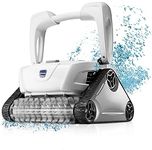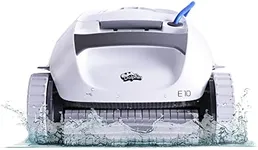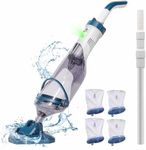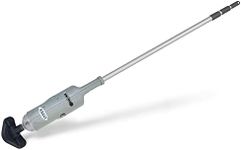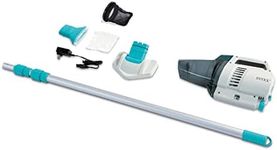Buying Guide for the Best Above Ground Pool Cleaners
Choosing the right above-ground pool cleaner can make maintaining your pool much easier and more enjoyable. The right cleaner will help keep your pool water clear and free of debris, saving you time and effort. When shopping for a pool cleaner, it's important to understand the main features and specifications so you can match them to your pool size, shape, and your own cleaning preferences. By focusing on the key specs, you can find a cleaner that fits your needs and keeps your pool sparkling all season long.Type of CleanerAbove-ground pool cleaners generally come in three types: manual, suction-side, and robotic. Manual cleaners require you to operate them by hand, which can be time-consuming but gives you control over the cleaning process. Suction-side cleaners connect to your pool’s filtration system and move around the pool using the suction from your pump, making them more hands-off but dependent on your pool’s pump strength. Robotic cleaners are self-contained units that run independently and often provide the most thorough cleaning with the least effort from you. If you want convenience and minimal effort, robotic cleaners are ideal, while manual or suction-side cleaners may suit those who don’t mind a bit of hands-on work or have smaller pools.
Pool Size CompatibilityThis spec refers to the maximum pool size or dimensions that the cleaner can handle effectively. Some cleaners are designed for small to medium pools, while others can handle larger pools. If your pool is on the larger side, make sure the cleaner’s hose length or cable is long enough to reach all areas. For smaller pools, a compact cleaner will be sufficient and easier to manage. Always check the recommended pool size to ensure the cleaner will cover your entire pool without missing spots.
Cleaning Coverage (Floor, Walls, Waterline)Some pool cleaners are designed to clean only the pool floor, while others can also clean the walls and even the waterline. Floor-only cleaners are usually simpler and suitable for pools with flat bottoms. If your pool has sloped sides or you want a more thorough clean, look for a model that can climb walls and scrub the waterline. Think about how much debris tends to collect on your pool’s walls and waterline to decide if you need this extra coverage.
Filtration and Debris HandlingThis refers to how the cleaner collects and stores debris. Some cleaners use bags or cartridges to trap dirt, leaves, and other debris. The capacity and type of filter will affect how often you need to empty it and how well it handles different sizes of debris. If your pool is surrounded by trees or gets a lot of leaves, choose a cleaner with a larger debris bag or a filter designed for larger particles. For mostly fine dirt or sand, a finer filter is more important.
Ease of Use and MaintenanceThis spec covers how simple it is to set up, operate, and maintain the cleaner. Some models are plug-and-play, requiring minimal assembly, while others may need more setup or regular maintenance. Consider how much time you want to spend on setup and cleaning the cleaner itself. If you prefer a hassle-free experience, look for models with easy-to-clean filters and straightforward controls.
Power SourcePool cleaners can be powered by your pool’s pump, by plugging into an electrical outlet, or by batteries. Suction-side cleaners use the pool’s pump, while robotic cleaners usually need an electrical outlet. Battery-powered options are less common but offer more portability. Think about your pool’s setup and where you have access to power when choosing the right power source for your cleaner.
